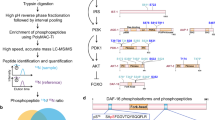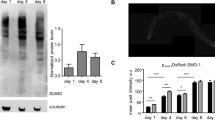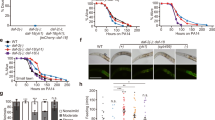Abstract
The PTEN tumour suppressor is a phosphatase that dephosphorylates phosphatidylinositol 3, 4, 5 triphosphate (PIP3) and protein substrates. PTEN function is modulated by its carboxy-terminal region, which contains several clustered phosphorylation sites and a PDZ-binding motif (PDZbm). Although PTEN growth suppression effect is well demonstrated, its additional biological roles are less well understood. DAF-18, a Caenorhabditis elegans homologue PTEN, is a component of the insulin/IGF-I signalling pathway that controls entry to the dauer larval stage and adult longevity. To further explore the role of PTEN in the insulin signalling cascade and its possible involvement in the mechanisms of ageing, we undertook a study of PTEN function in C. elegans. We now report that human PTEN can substitute for DAF-18 and restores the dauer and longevity phenotypes in worms devoid of DAF-18. Furthermore, we provide genetic and biochemical evidence that dauer and lifespan control depends on PTEN-mediated regulation of PIP3 levels. Finally, we established that phosphorylation sites in the C-terminus of PTEN and its PDZbm are necessary for PTEN control of the insulin/IGF-I pathway. These results demonstrate that PTEN negatively regulates the insulin/IGF pathway in a whole organism and raise the hypothesis that PTEN may be involved in mammalian ageing.
This is a preview of subscription content, access via your institution
Access options
Subscribe to this journal
Receive 50 print issues and online access
$259.00 per year
only $5.18 per issue
Buy this article
- Purchase on Springer Link
- Instant access to full article PDF
Prices may be subject to local taxes which are calculated during checkout




Similar content being viewed by others
References
Adey NB, Huang L, Ormonde PA, Baumgard ML, Pero R, Byreddy DV, Tavtigian SV and Bartel PL . (2000). Cancer Res., 60, 35–37.
Birle D, Bottini N, Williams S, Huynh H, deBelle I, Adamson E and Mustelin T . (2002). J. Immunol., 169, 286–291.
Bligh EG and Dyer WJ . (1959). Can. J. Biochem. Physiol., 37, 911–918.
Blüher M, Kahn BB and Khan CR . (2003). Science, 299, 572–574.
Bonneau D and Longy M . (2000). Hum. Mutat., 16, 109–122.
Bossinger O, Klebes A, Segbert C, Theres C and Knust E . (2001). Dev. Biol., 230, 29–42.
Brenner S . (1974). Genetics, 77, 71–94.
Cantley LC and Neel BG . (1999). Proc. Natl. Acad. Sci. USA, 96, 4240–4245.
Clancy DJ, Gems D, Harshman LG, Oldham S, Stocker H, Hafen E, Leevers SJ and Partridge L . (2001). Science, 292, 41–43.
Dorman JB, Albinder B, Shroyer T and Kenyon C . (1995). Genetics, 141, 1399–1406.
Eng C . (2003). Hum. Mutat., 22, 183–198.
Furnari FB, Huang HJ and Cavenee WK . (1998). Cancer Res., 58, 5002–5008.
Georgescu MM, Kirsch KH, Akagi T, Shishido T and Hanafusa H . (1999). Proc. Natl. Acad. Sci. USA, 96, 10182–10187.
Gil EB, Malone Link E, Liu LX, Johnson CD and Lees JA . (1999). Proc. Natl. Acad. Sci. USA, 96, 2925–2930.
Gottlieb S and Ruvkun G . (1994). Genetics, 137, 107–120.
Gu J, Tamura M and Yamada KM . (1998). J. Cell Biol., 143, 1375–1383.
Haas-Kogan D, Shalev N, Wong M, Mills G, Yount G and Stokoe D . (1998). Curr. Biol., 8, 1195–1198.
Holzenberger M, Dupont J, Ducos B, Leneuve P, Geloen A, Even PC, Cervera P and Le Bouc Y . (2003). Nature, 421, 182–187.
Kenyon C, Chang J, Gensch E, Rudner A and Tabtiang R . (1993). Nature, 366, 461–464.
Larsen PL, Albert PS and Riddle DL . (1995). Genetics, 139, 1567–1583.
Lee JO, Yang H, Georgescu MM, Di Cristofano A, Maehama T, Shi Y, Dixon JE, Pandolfi P and Pavletich NP . (1999). Cell, 99, 323–334.
Leslie NR, Bennett D, Gray A, Pass I, Hoang-Xuan K and Downes CP . (2001). Biochem. J., 357, 427–435.
Leslie NR, Gray A, Pass I, Orchiston EA and Downes CP . (2000). Biochem. J., 346 (Part 3), 827–833.
Li DM and Sun H . (1998). Proc. Natl. Acad. Sci. USA, 95, 15406–15411.
Lin K, Dorman JB, Rodan A and Kenyon C . (1997). Science, 278, 1319–1322.
Maehama T and Dixon JE . (1998). J. Biol. Chem., 273, 13375–13378.
Maehama T, Taylor GS and Dixon JE . (2001). Annu. Rev. Biochem., 70, 247–279.
Mihaylova VT, Borland CZ, Manjarrez L, Stern MJ and Sun H . (1999). Proc. Natl. Acad. Sci. USA, 96, 7427–7432.
Morimoto AM, Berson AE, Fujii GH, Teng DH, Tavtigian SV, Bookstein R, Steck PA and Bolen JB . (1999). Oncogene, 18, 1261–1266.
Morris JZ, Tissenbaum HA and Ruvkun G . (1996). Nature, 382, 536–539.
Myers MP, Pass I, Batty IH, Van der Kaay J, Stolarov JP, Hemmings BA, Wigler MH, Downes CP and Tonks NK . (1998). Proc. Natl. Acad. Sci. USA, 95, 13513–13518.
Myers MP, Stolarov JP, Eng C, Li J, Wang SI, Wigler MH, Parsons R and Tonks NK . (1997). Proc. Natl. Acad. Sci. USA, 94, 9052–9057.
Nakamura N, Ramaswamy S, Vazquez F, Signoretti S, Loda M and Sellers WR . (2000). Mol. Cell. Biol., 20, 8969–8982.
Niebuhr K, Giuriato S, Pedron T, Philpott DJ, Gaits F, Sable J, Sheetz MP, Parsot C, Sansonetti PJ and Payrastre B . (2002). EMBO J., 21, 5069–5078.
Ogg S, Paradis S, Gottlieb S, Patterson GI, Lee L, Tissenbaum HA and Ruvkun G . (1997). Nature, 389, 994–999.
Ogg S and Ruvkun G . (1998). Mol. Cell, 2, 887–893.
Paradis S and Ruvkun G . (1998). Genes Dev., 12, 2488–2498.
Payrastre B, Missy K, Giuriato S, Bodin S, Plantavid M and Gratacap M . (2001). Cell Signal., 13, 377–387.
Riddle DL . (1997). C. elegans II Riddle DL, Blumenthal T, Meyer BJ and Priess JR (eds) Cold Spring Harbor Press: Cold Spring Harbor, NY, 739–768.
Rouault JP, Kuwabara PE, Sinilnikova OM, Duret L, Thierry-Mieg D and Billaud M . (1999). Curr. Biol., 9, 329–332.
Saltiel AR and Kahn CR . (2001). Nature, 414, 799–806.
Simpson L and Parsons R . (2001). Exp. Cell Res., 264, 29–41.
Stambolic V, Suzuki A, de la Pompa JL, Brothers GM, Mirtsos C, Sasaki T, Ruland J, Penninger JM, Siderovski DP and Mak TW . (1998). Cell, 95, 29–39.
Tamura M, Gu J, Matsumoto K, Aota S, Parsons R and Yamada KM . (1998). Science, 280, 1614–1617.
Tatar M, Kopelman A, Epstein D, Tu MP, Yin CM and Garofalo RS . (2001). Science, 292, 107–110.
Tolkacheva T, Boddapati M, Sanfiz A, Tsuchida K, Kimmelman AC and Chan AM . (2001). Cancer Res., 61, 4985–4989.
Tolkacheva T and Chan AM . (2000). Oncogene, 19, 680–689.
Torres J and Pulido R . (2001). J. Biol. Chem., 276, 993–998.
Vazquez F, Grossman SR, Takahashi Y, Rokas MV, Nakamura N and Sellers WR . (2001). J. Biol. Chem., 276, 48627–48630.
Vazquez F, Ramaswamy S, Nakamura N and Sellers WR . (2000). Mol. Cell. Biol., 20, 5010–5018.
Wu X, Hepner K, Castelino-Prabhu S, Do D, Kaye MB, Yuan XJ, Wood J, Ross C, Sawyers CL and Whang YE . (2000a). Proc. Natl. Acad. Sci. USA, 97, 4233–4238.
Wu Y, Dowbenko D, Spencer S, Laura R, Lee J, Gu Q and Lasky LA . (2000b). J. Biol. Chem., 275, 21477–21485.
Acknowledgements
We are grateful to Drs G Ruvkun and P Hu for kindly providing the mg198 strain. We thank Dr NR Leslie for PTEN 399STOP mutant and Dr Yuji Kohara for cDNA clones. This work was supported by grants from la Ligue Nationale Contre le Cancer (équipe labellisée), Association pour la Recherche contre le Cancer Contract no. 4794 and ARECA-Toulouse. AMC is supported by grants from the NIH (CA95063) and DOD (17-03-1-0682).
Author information
Authors and Affiliations
Corresponding author
Rights and permissions
About this article
Cite this article
Solari, F., Bourbon-Piffaut, A., Masse, I. et al. The human tumour suppressor PTEN regulates longevity and dauer formation in Caenorhabditis elegans. Oncogene 24, 20–27 (2005). https://doi.org/10.1038/sj.onc.1207978
Received:
Revised:
Accepted:
Published:
Issue Date:
DOI: https://doi.org/10.1038/sj.onc.1207978
Keywords
This article is cited by
-
Parental energy-sensing pathways control intergenerational offspring sex determination in the nematode Auanema freiburgensis
BMC Biology (2021)
-
A PTEN variant uncouples longevity from impaired fitness in Caenorhabditis elegans with reduced insulin/IGF-1 signaling
Nature Communications (2021)
-
Insulin/IGF-1 signaling promotes immunosuppression via the STAT3 pathway: impact on the aging process and age-related diseases
Inflammation Research (2021)
-
The precursor of PI(3,4,5)P3 alleviates aging by activating daf-18(Pten) and independent of daf-16
Nature Communications (2020)
-
Insulin activates the insulin receptor to downregulate the PTEN tumour suppressor
Oncogene (2014)



